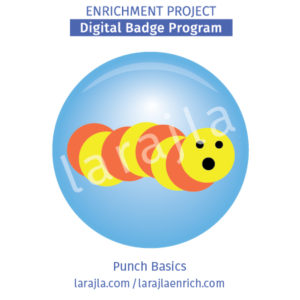
Using punched shapes may be as simple as using a single shape, using multiples to create an image or even using parts of punched shapes to create unique designs. Let’s try some basic steps to get used to working with paper punches.
Steps
1. Repeat.
If you are planning to punch paper for a craft like teabag folding, you want to make sure the pieces you use all match. You’ll also want to do this if you’re planning on making multiples of a piece. While it’s easy to do so with pre-made paper, if you plan on using other paper (such as wrapping paper), it’s not quite as easy as the patterns aren’t broken into nice little squares for you. Using a punch is a great way to get consistently designed squares. Try it!
2. Size.
Another reason to use punches is when you need items to be a specific size. Inchies are small pieces of art that are 1” in size. You can get paper punches that are 1” square. Be sure to check the actual punch as some punches are not truly 1”. For starting a design, a punched shape can give you a consistent starting point.
3. Inside.
Putting an image inside a preformed area is another great reason to use punches. For example, a 1” circle fits perfectly into a bottle cap. You might also find in the jewelry section of your craft store punches that go with charms so that you can punch images to fit a specific piece. Explore pairing a punch’s shape with a specific item to make crafting easier.
4. Stencil.
Cutouts can be used as stencils where you add ink or paint in the empty area to the paper below. You can also use the punched shape as a resist to create an area where the ink or paint around the paper actually creates the border. Try playing with punched shapes / cutouts as stencils.
NOTE: For a visual of using a punched image as a stencil, see the appropriate supplement listed below.
5. Layering.
Punching out varying sizes of a similar shape allows you to layer different colors to create an interesting border for your images. Another term for this is “nesting.” Punch two or three different sizes of a circle, square or other shape and stack them to see the effect you can achieve. For variety, you can also layer dissimilar shapes to create a different look. Layering can be found in greeting cards . . . so make one using multiple punched shapes.
6. Two.
When you want a shape out of a shape, like a shape in a balloon, you want to punch the inside shape first. You can then determine where you want that shape to appear in your larger shape by looking where it rests from the bottom of the punch. When you’re happy with the placement of the first punched area and the new one, punch your shape. Play with punching a shape (or more) inside another.
7. Assembly.
Putting multiple shapes together to make something else can be simple as circles to make a caterpillar or complicated like assembling a punched flower. Try assembling multiple shapes to create something new.
8. Shape.
Punched shapes don’t need to remain flat. A stylus (ball) can be used with a foam mat to shape the punched shapes. You can also add water to do more shaping. Experiment with various shapes.
9. Edges.
Some punches are designed to create edges, borders, frames or corners. You can also use a corner punch on a tag to add a little interest. You can punch the flap of an envelope to make it appear more elegant. Some punches are designed with special bases or accessories to help you align the punch so you can punch a smaller area repeatedly to create a longer border for an item like a scrapbook page. Create a frame or border using paper and punches.
10. Beads.
Create paper beads by punching out multiples of the same shape. Fold all of the shapes in half and glue the folds together. The inner “hole” is formed when the shapes are glued together with the folded edges together. You can use these for jewelry, ornaments, garlands, etc. Try making a shape to see if you like the process.
11. Play.
Now that you’ve started your punching adventure, start experimenting on your own and see if you can come up with some really cool projects.
Badge and Supplement Files
Member Level
- 0EP_B_BPG_PunchB_2in_12up_MS1_larajla — generic badge printable
- 0EP_BLIST_PunchB_MS1_larajla — badge items per membership level
- 0EP_BSET0_PunchB_MS1_larajla —badge set and related badges
- 0EP_SUPP0_PunchB_Journal_MS1_larajla — badge journal
- 0EP_SUPP0_PunchB_Planner_MS1_larajla — badge planner
- 0EP_SUPPL_PunchB_MS1_larajla — supplements currently available per membership level
Supplement Fun
- 0EP_SUPP0_Instruct Fun_Paper Punch Usage_MS2_larajla — Instruct Fun: Paper punch usage (stencil and resist)
Sites to Explore
- www.paperpunchaddiction.com
- www.splitcoaststampers.com/gallery/showgallery.php?cat=14545
- www.bhg.com/crafts/scrapbooking/techniques/cutting/paper-punch-techniques-for-scrapbooking
- www.craft-a-project.com/punch-art.html
- jackietopa.typepad.com/addicted_to_stamping/punch-art
- www.pinterest.com/sassysangels/paper-punch-art
- www.pinterest.com/jvik/punch-art
- www.pinterest.com/windy1264/punch-art-ideas
- www.pinterest.com/adredfearn/punch-art-paper-piecing-patterns
Get the infographic here > larajla blog post
Get the PDFs of the badge program / supplements here